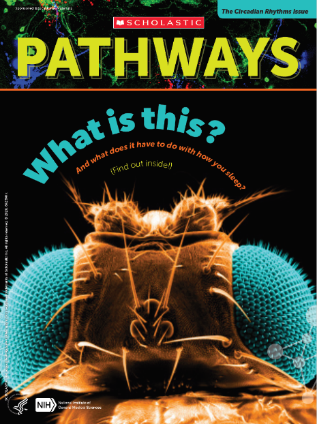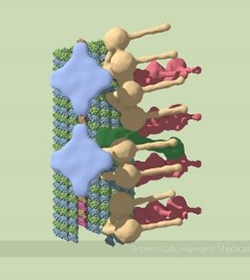Sudden changes to our schedules, like the end of daylight saving time this Sunday or flying across time zones, often leave us feeling off kilter because they disrupt our bodies’ circadian rhythms. Circadian rhythms are physical, mental, and behavioral changes that follow a daily cycle. When these “biological clocks” are disrupted, our bodies eventually readjust. However, some people have conditions that cause their circadian rhythms to be permanently out of sync with their surroundings.
Continue reading “Scientist Interview: Investigating Circadian Rhythms With Michael W. Young”Tag: Cool Videos
How I Got Here: A Webinar on Following Your Own Career Path
There is no single avenue to a scientific career—the paths are as diverse as the people who pursue them. In a recent webinar, two NIGMS-supported researchers shared their unique journeys as scientists and their advice for those seeking careers in the field. The webinar is part of a series from NIGMS created for the research training community—students, postdocs, and faculty. Experts focus on topics from infectious disease modeling to virtual teaching and learning.
Continue reading “How I Got Here: A Webinar on Following Your Own Career Path”Explore Our STEM Education Resources for the New School Year
If you’re looking for ways to engage students in science this school year, NIGMS offers a range of free resources that can help. All of our STEM materials are online and print-friendly, making them easy to use for remote teaching.
Pathways , developed in collaboration with Scholastic, is aligned with STEM and ELA education standards for grades 6 through 12. Materials include:
- Student magazines with corresponding teaching guides
- Related lessons with interactives
- Videos
- Vocabulary lists
 Cover of Pathways student magazine, third issue.
Cover of Pathways student magazine, third issue.
Available lessons examine basic science careers, regeneration, and circadian rhythms.
Continue reading “Explore Our STEM Education Resources for the New School Year”Scientist Interview: Studying the Biochemistry of Insects with Michael Kanost
Insects vastly outnumber people on our planet. Some are pests, but many are key parts of their ecosystems, and some may even hold secrets for developing new materials that researchers could use in the medical field. Michael Kanost, Ph.D., a professor of biochemistry and molecular biophysics at Kansas State University in Manhattan, Kansas, has been researching the biochemistry of insects for more than 30 years. His lab studies the tobacco hornworm, a mosquito that carries malaria, and the red flour beetle to better understand insect exoskeletons and immune systems.
Continue reading “Scientist Interview: Studying the Biochemistry of Insects with Michael Kanost”Check Out Our Pinterest Board of Virtual Learning STEM Resources
The National Institute of General Medical Sciences (NIGMS) has new resources on Pinterest! Follow NIGMS and access engaging science education materials, including virtual learning activities, scientific images, basic science articles, and more.
Continue reading “Check Out Our Pinterest Board of Virtual Learning STEM Resources”Explore Our Virtual Learning STEM Resources
If you’re looking for engaging ways to teach science from home, NIGMS offers a range of resources that can help.
 A SEPA-funded resource about microbes. Credit: University of Nebraska, Lincoln.
A SEPA-funded resource about microbes. Credit: University of Nebraska, Lincoln.
Our Science Education and Partnership Award (SEPA) webpage features free, easy-to-access STEM and informal science education projects for pre-K through grade 12. Aligned with state and national standards for STEM teaching and learning, the program has tools such as:
- Apps
- Interactives
- Online books
- Curricula and lesson plans
- Short movies
Students can learn about sleep, cells, growth, microbes, a healthy lifestyle, genetics, and many other subjects.
Continue reading “Explore Our Virtual Learning STEM Resources”Revealing a Piece of Cilia’s Puzzle
 A partial model of a doublet microtubule. Credit: Veronica Falconieri.
A partial model of a doublet microtubule. Credit: Veronica Falconieri.
Cilia (cilium in singular) are complex organelles found on all of our cells except red blood cells. Their rhythmic beating moves fluid or materials over the cell to help transport food and oxygen or remove debris. For example, cilia in our windpipe prevent bacteria and mucous from traveling to the lungs. Some pick up signals like antennae, such as cilia in our ears that help detect sounds. One component of cilia is the doublet microtubule, a major part of cilia’s skeleton that gives it strength and rigidity.
Continue reading “Revealing a Piece of Cilia’s Puzzle”Get Kids Excited About Science: Free STEM Resources
 Credit: University of Nebraska, Lincoln.
Credit: University of Nebraska, Lincoln.We have a new Science Education and Partnership Award (SEPA) webpage, featuring free, easy-to-access, SEPA-funded resources that educators nationwide can use to engage their students in science. The SEPA program supports innovative STEM and informal science education projects for pre-kindergarten through grade 12. The program includes tools that teachers, scientists, and parents can use to excite kids about science and research, such as:
Continue reading “Get Kids Excited About Science: Free STEM Resources”Cilia: Tiny Cell Structures With Mighty Functions
 Credit: Zvonimir Dogic, Brandeis University.
Credit: Zvonimir Dogic, Brandeis University.
Imagine an army of tiny soldiers stationed throughout your body, lining cells from your brain to every major organ system. Rather than standing at attention, this tiny force sweeps back and forth thousands of times a minute. Their synchronized action helps move debris along the ranks to the nearest opening. Other soldiers stand as sentries, detecting changes in your environment, relaying that information to your brain, and boosting your senses of taste, smell, sight, and hearing.
Your brain may be the commander in chief, but these rank-and-file soldiers are made up of microscopic cell structures called cilia (cilium in singular).
Here we describe these tiny but mighty cell structures in action.
Continue reading “Cilia: Tiny Cell Structures With Mighty Functions”On this Darwin Day, Evolutionary Geneticist Dr. Dan Janes Discusses the Scientific Contributions of Charles Darwin
This Sunday, February 12, is Darwin Day—an occasion to recognize the scientific contributions of 19th-century naturalist Charles Darwin. In this video (originally posted on Darwin Day 2016), our own evolutionary geneticist, Dan Janes, answers questions about Darwin and the role of evolution in health and biomedicine.

